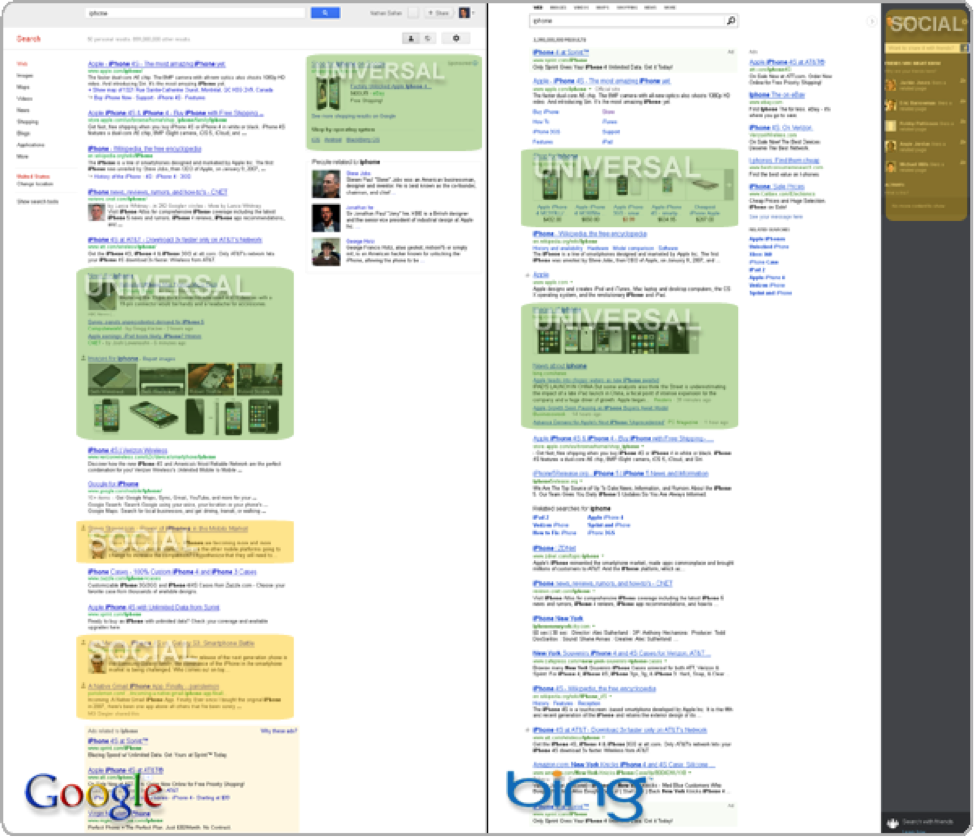The Bing Dilemma: What To Do With The Little Search Engine That Can’t
The challenge that Microsoft faces in the online search landscape could be a business school case study: how to capture market share from a competitor whose very brand (“Google”) has become synonymous with the act of searching online. Imagine that you are the person at Microsoft responsible for Bing’s success and are tasked with moving […]
The challenge that Microsoft faces in the online search landscape could be a business school case study: how to capture market share from a competitor whose very brand (“Google”) has become synonymous with the act of searching online.
Imagine that you are the person at Microsoft responsible for Bing’s success and are tasked with moving the needle on market share. It seems to me you’d have three basic strategic options: out-feature the competition, develop the brand and go on the attack.
1. Out-Feature
Differentiate from the competition by “out-featuring” Google — i.e., adding shiny new features to the search results.
Among other tactics, Bing has tried adding Facebook to their search engine results page (as seen in the right frame of the image below).
Many of these attempts seemed to be a solution in search of a problem; for example, research has shown that a majority of searchers (62%) do not want social results within search results.
2. Develop The Brand
Attempt to shift market share by first shifting mindshare; make the Bing brand top of mind via product placement and traditional media advertising.
Bing has made appearances in many movies and TV shows, including Spiderman and Source Code (shown below). These placements do not come cheap — placement in a blockbuster movie can run in the tens of millions of dollars.
3. Go On The Attack
If the above two approaches are not bearing fruit, it’s time to go on the attack.
Bing has been doing this over the past couple of years with their “Scroogled” campaign, which originally highlighted Google’s shift to a pay-for-play shopping search engine. In the last 12+ months, Microsoft has shown an increased willingness to go on the offensive with aggressive campaigns on tablets, mobile and even the Chromebook.
Has It Really Worked?
Now, as the individual responsible for Bing’s strategy, you might agree that the above represents a linear progression in thinking. That is, you might start out in your quest for market share by attempting to out-feature the incumbent, progress to a brand development strategy, and finally, if those tactics do not work, go on the attack and attempt to wrest market share away.
By all accounts, the strategies do not appear to be working. According to comScore, Google’s search engine market share has been flat since 2010:
Other market share data sources show similarly flat lines for Bing, with some putting Google market share as high as 80+%. When users search online, they still very much “Google,” and even the latest Bing attack strategy seems to have had little to no impact.
Now, if the above does, in fact, represent a linear progression — building, then branding, and finally culminating in attack ads — it would seem that Microsoft’s strategic options when it comes to Bing are running out. Where is there to go, after an aggressive attack on the competition? Combine that with the fact that Microsoft’s online division still loses hundreds of millions of dollars a quarter — more than $10 Billion since 2005! — and it seems like the right time for us to pause and consider what their options may be going forward.
It seems to me they have three basic options:
1. Fight The Fight! There Are Bazillions At Stake!
Forrester Research puts the size of the search industry at more than $33 billion by 2016. That represents nearly half of all of Microsoft’s annual revenue. With so much at stake, the “fight the fight” approach dictates that Microsoft concedes no ground, and Bing continues to plow forward in an attempt to seize market share from Google.
2. The Skeleton Approach
This strategy is one where Microsoft reduces expenses to a minimum level to maintain the search engine, but does not devote significant dollars to R&D or new customer acquisition. Some degree of this may already be happening as the trend line of losses in the chart above continues to go down quarter over quarter. The downside is that barring some kind of catastrophic stumble by Google, Microsoft is essentially giving up on new customer acquisition.
3. Give Up
With online search so critical to online user activity, it’s hard to imagine a scenario where Microsoft gives up either by selling or by closing up shop entirely, but it remains a possibility. (Could you imagine a scenario where Apply buys Bing and “Apple-fies” it?) Of course, Google would not want Microsoft to throw in the towel because of monopoly considerations.
Things seem to be coming to a head for Bing with the online division still bleeding a billion dollars a year and no market share gains to show for it. Another cog is the imminent arrival of a new CEO at Microsoft; you’d have to think one of the first things any new CEO will do is look at the financials of every division and notice that the online division is bleeding rivers of cash with little to show for it.
Does this mean that we will see drastic changes coming from Bing in the near future? Maybe; maybe not. But either way, the confluence of factors that include the tactics to grab market share are not working. The bleeding of money and the arrival of new management could mean changes are coming.
To be sure, the challenge in shifting consumers away from a behavior that is so ingrained in consumer consciousness as to have its own entry in the dictionary is so substantial it may be unprecedented in the history of modern marketing. What would you do with Bing if you were the new Microsoft CEO?
Editor’s note: A previous version of this article mistakenly switched up the statistics in the Search Engine Market Share chart, attributing Yahoo share to Microsoft and vice versa. That error has since been corrected.
Contributing authors are invited to create content for Search Engine Land and are chosen for their expertise and contribution to the search community. Our contributors work under the oversight of the editorial staff and contributions are checked for quality and relevance to our readers. The opinions they express are their own.
Related stories
New on Search Engine Land



